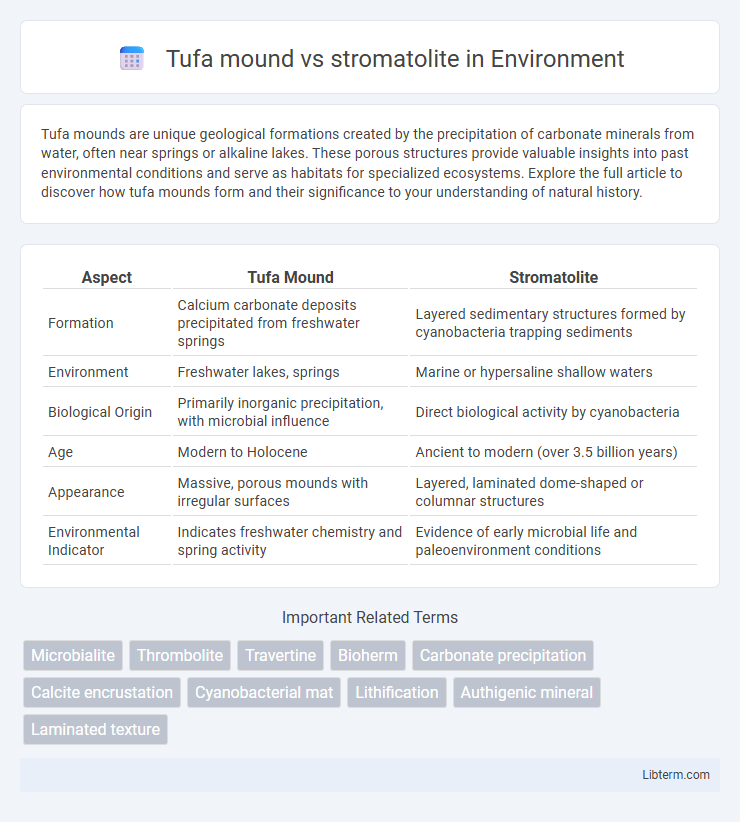Tufa mounds are unique geological formations created by the precipitation of carbonate minerals from water, often near springs or alkaline lakes. These porous structures provide valuable insights into past environmental conditions and serve as habitats for specialized ecosystems. Explore the full article to discover how tufa mounds form and their significance to your understanding of natural history.
Table of Comparison
| Aspect | Tufa Mound | Stromatolite |
|---|---|---|
| Formation | Calcium carbonate deposits precipitated from freshwater springs | Layered sedimentary structures formed by cyanobacteria trapping sediments |
| Environment | Freshwater lakes, springs | Marine or hypersaline shallow waters |
| Biological Origin | Primarily inorganic precipitation, with microbial influence | Direct biological activity by cyanobacteria |
| Age | Modern to Holocene | Ancient to modern (over 3.5 billion years) |
| Appearance | Massive, porous mounds with irregular surfaces | Layered, laminated dome-shaped or columnar structures |
| Environmental Indicator | Indicates freshwater chemistry and spring activity | Evidence of early microbial life and paleoenvironment conditions |
Introduction to Tufa Mounds and Stromatolites
Tufa mounds are porous calcium carbonate formations created primarily by the precipitation of minerals from ambient water, often found in freshwater environments such as springs and lakes. Stromatolites are layered bio-chemical accretionary structures formed by the trapping, binding, and cementation of sedimentary grains by cyanobacteria and other microbial mats, representing some of the oldest evidence of life on Earth. Both tufa mounds and stromatolites serve as significant geological and biological indicators, with tufas highlighting modern carbonate depositional systems and stromatolites offering insights into Precambrian ecosystems.
Formation Processes: Tufa Mounds vs Stromatolites
Tufa mounds form primarily through the precipitation of calcium carbonate from spring or lake waters rich in dissolved calcium ions, often influenced by microbial activity and environmental factors like water temperature and pH. Stromatolites develop as layered bio-chemical accretionary structures created by cyanobacteria trapping, binding, and cementing sediment grains, promoting carbonate buildup through photosynthetic activity. While tufa mounds result mainly from inorganic chemical precipitation enhanced by microbes, stromatolites are predominantly biogenic, showcasing complex interactions between microbial mats and sedimentation over geological timescales.
Key Differences in Mineral Composition
Tufa mounds primarily consist of calcium carbonate minerals such as calcite and aragonite, formed through the precipitation of carbonate minerals from ambient water rich in calcium ions. Stromatolites are layered bio-chemical accretions dominated by carbonate minerals but also contain significant amounts of microbial organic matter, often trapping fine sediments. The key difference lies in tufa's abiotic precipitation process versus stromatolites' biogenic origin, with stromatolites exhibiting more complex mineral-organic intergrowths.
Biological vs. Abiotic Influences
Tufa mounds primarily form through abiotic processes involving the precipitation of calcium carbonate from mineral-rich waters, often influenced by environmental conditions such as temperature and pH. Stromatolites develop through biological activity, specifically the trapping and binding of sediment by cyanobacteria and microbial mats, which facilitate mineral accretion. The distinct contrast lies in tufa mounds being predominantly chemical deposits with environmental drivers, while stromatolites represent biogenic structures shaped by microbial lifeforms.
Typical Environments and Locations
Tufa mounds typically form in freshwater environments such as springs, lakes, and rivers rich in calcium carbonate, with notable examples in Mono Lake, California, and the Great Salt Lake, Utah. Stromatolites develop primarily in shallow, hypersaline marine and lacustrine settings where cyanobacteria thrive, with famous locations including Shark Bay in Western Australia and the Bahamas. Both structures serve as important records of biological and geochemical processes in their respective environments.
Role in Earth’s Geological History
Tufa mounds and stromatolites both serve as crucial records of Earth's geological and environmental evolution, with stromatolites representing some of the earliest evidence of life dating back over 3.5 billion years, formed by cyanobacteria trapping sediments. Tufa mounds, primarily composed of calcium carbonate precipitated from freshwater springs, provide insight into more recent geological processes related to hydrology and climate changes in the Quaternary period. The persistence of stromatolites highlights early microbial ecosystems' role in oxygenating the atmosphere, while tufa deposits inform studies of sedimentary environments and paleoecology in terrestrial settings.
Visual and Structural Comparison
Tufa mounds exhibit a porous, spongy texture formed primarily from calcium carbonate precipitated by freshwater springs, often displaying irregular, bulbous shapes with visible cavities. Stromatolites feature layered, laminated structures created by cyanobacterial mats trapping sediment, resulting in distinctive, finely banded patterns and dome-like or columnar forms. Visually, tufa mounds appear more rugged and less uniform, while stromatolites showcase smooth, repetitive stratifications indicative of biological activity.
Ecological Importance and Modern Relevance
Tufa mounds and stromatolites both play critical roles in their ecosystems by providing habitats and influencing local water chemistry, with tufa mounds often forming around freshwater springs rich in calcium carbonate, supporting diverse aquatic life. Stromatolites, created by cyanobacteria, are among the oldest evidence of life on Earth, contributing to oxygen production and carbon cycling, which remains vital in modern microbial mats aiding nutrient cycling in some extreme environments. Their ecological importance lies in maintaining biodiversity and ecological balance, while their modern relevance extends to studies in climate change, bioindicators, and astrobiology research.
Methods for Identifying Each Structure
Tufa mounds are identified through petrographic analysis revealing calcium carbonate precipitates from freshwater springs, often associated with microbial mats and aquatic vegetation. Stromatolites are recognized by their laminated, layered structures formed by cyanobacteria trapping and binding sediments, detectable via microscopic examination highlighting biogenic fabric and stromatolitic lamination patterns. Geochemical signatures such as isotopic compositions and mineralogy further differentiate tufa mounds from stromatolites in sedimentological studies.
Future Research and Scientific Implications
Future research on tufa mounds and stromatolites will enhance our understanding of microbialite formation and paleoenvironmental conditions, offering insights into Earth's early biosphere and climate changes. Advanced geochemical analyses and high-resolution imaging technologies can elucidate the distinct microbial communities and mineralization processes governing their development. Exploring these biogenic structures' potential as analogs for extraterrestrial life detection can significantly influence astrobiology and planetary science.
Tufa mound Infographic

 libterm.com
libterm.com